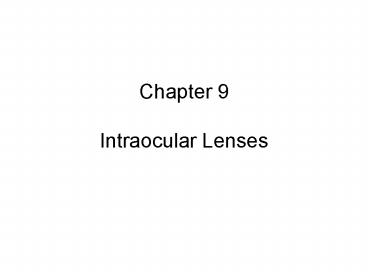Chapter 9 Intraocular Lenses - PowerPoint PPT Presentation
1 / 26
Title:
Chapter 9 Intraocular Lenses
Description:
Chapter 9 Intraocular Lenses Aphakic IOL Implantation Older IOLs inflexible (e.g. PMMA), so larger incision was required Larger incision often led to significant (and ... – PowerPoint PPT presentation
Number of Views:533
Avg rating:3.0/5.0
Title: Chapter 9 Intraocular Lenses
1
Chapter 9Intraocular Lenses
2
Aphakic IOL Implantation
Page 9.1
- Older IOLs inflexible (e.g. PMMA), so larger
incision was required - Larger incision often led to significant (and
variable) post-surgical astigmatism - Newer designs are foldable allowing much smaller
incisions - Most cataract extractions today are extracapsular
(capsule remains intact) allows easy insertion
of foldable implants
3
Early Anterior Chamber IOLs (1960s)
Fig 9.1 Page 9.1
- Intracapsular cataract extraction
- PMMA Iris Clip Lens placed in anterior chamber
- Many iris-related problems iritis, pupil
distortion, corneal endothelial cell loss
4
Posterior Chamber IOLs (1977)
Fig 9.2 Page 9.2
- Extracapsular cataract extraction (capsule
remains intact) now in vogue - Allowed posterior chamber implantation, initially
in ciliary sulcus - Capsular bag soon took over as implant site of
choice because of problems with ciliary sulcus
implants (e.g. pigmentary glaucoma)
5
Fig 9.3 Page 9.2
Ciliary Sulcus
6
Fig 9.4 Page 9.3
Posterior Chamber IOL in Ciliary Sulcus
7
Sutured Haptic tied off and knot buried in
conjunctiva
Fig 9.5 Page 9.3
8
Fig 9.6 Page 9.4
Capsular Bag Implant
9
Fig 9.7 Page 9.4
IOL inside Capsular Bag
10
Fig 9.8 Page 9.4
Newer Capsular Bag Lenses
11
Phakic IOLs
Page 9.5
- Emergence of phakic IOLs in mid-1980s, as
biocompatible foldable materials became available - Phakic IOLs exclude the ciliary sulcus and
capsular bag as implant sites - AC IOLs therefore returned
- Had to overcome the previous iris-related
problems with AC lens - Advantage over LASIK, PRK etc. ? reversible
12
Fig 9.9, Page 9.5
- Iris claw lens (Artisan, 1998)
- Not feasible with AC depth lt 3.2 mm
- This impacted primarily the hyperopic pool
- Unfortunate because hyperopes have lower success
rate with corneal refractive surgery than myopes - Complications (e.g. endothelial cell loss, glare,
etc.) remain but appear to be decreasing with
newer designs
13
Posterior Chamber Phakic IOLs
Fig 9.10 Page 9.6
- Collamer posterior chamber phakic ICL
(implantable contact lens) - Implanted between iris and anterior crystalline
lens - Contact with anterior lens causes anterior
subcapsular cataract - Iris problems also occur
- Best option for hyperopes
- PC location means higher lens power than
equivalent corneal power change with LASIK
14
IOLs and near Vision
Page 9.7
- Multifocal intraocular lenses are the IOL
equivalent of multifocal contact lenses - Poor track record until recently
15
Fig 9.12 Page 9.8
Array Multifocal Lens
- Alternating distance and intermediate/near zones
16
Fig 9.13 Page 9.8
Accommodating IOLs
- Humanoptics aphakic IOL
- Capsular bag-fixated lens
- Four flexible haptics that bend when constricted
by capsular bag - Effect ? forward translation of lens
- This increases total ocular power
17
Humanoptics Accommodating IOL
unaccommodated
accommodated
18
Post-operatively Adjustable IOLs
Page 9.7
- Photosensitive silicone matrix polymerizes with
UV exposure (a) - If central region polymerized (b) the chemical
imbalance causes unpolymerized peripheral matrix
to diffuse centrally - (c) result is increased IOL power
19
IOL Power Formulae
Page 9.10
- Goal calculate the IOL power required for
emmetropia - Early formulae based on two ocular variables
only axial length and mean corneal power e.g.
SRK I Formula - Outcome totally dependent on ultrasonography
(ax?, or L) and keratometry estimate of total
corneal power (K mean power) - Later variant SRK II addressed inaccuracies of
SRK I at the extremes of axial length
20
Intraocular Implant Design
- SRK I Formula
SRK Sanders-Retzlaff-Kraff (developers of
formula)
21
Implant Design Example
IOL with A value of 116.5 Patient K _at_ 90
43.75 D K _at_ 180 44.00 D ? mean K 43.875
D Axial length 24.03 mm
22
Intraocular Implant Design
- The SRK II Formula allows for errors at the
extremes of axial length with SRK I - Makes adjustments to IOL type constant, A
A1 A 3 axial lengths lt 20 mm A1 A 2 axial
lengths between 20 21 mm A1 A 1 axial
lengths between 21 22 mm A1 A axial lengths
between 22 24.5 mm A1 A ? 0.5 axial lengths gt
24.5 mm
23
Short Axial Length Example
Same IOL design with A value of 116.5 Patient
K _at_ 90 47.25 D K _at_ 180 48.75 D ? mean K
48.00 D Axial length 20.57 mm ? A1 A 2
(20-21 mm range)
using A ? 21.88 D
24
Page 9.10
Limitation of all 2-Variable Formulae
- No allowance for anterior chamber depth
- Example three patients, all with mean K (corneal
power) 43.05 D and axial length 24.17 mm (?
standard emmetropic eye) - Patient 1 AC depth 2.8 mm
- Patient 2 AC depth 3.6 mm
- Patient 3 AC depth 4.4 mm
- Outcome of SRK I formula (II not needed for
standard axial length) for capsular bag implant - Patient 2 emmetropic
- Patient 1 (shorter AC depth) is now myopic can
see OK to read, but distance blurred - Patient 3 (longer AC depth) is now hyperopic
cannot see to read cannot see at distance (no
accommodation)
25
Three-Variable Formulae (new variable AC depth)
- SRK/T formula adds an iris location variable, ?
allow for AC depth - Effect of IOL location?
Page 9.10
- As AC depth increases, IOL power should increase
- Likewise, IOL location (AC vs. ciliary sulcus vs.
capsular bag) affects required power - AC implant longest dcornea ? IOL location ?
lowest power - Ciliary sulcus shorter d ? higher power
- Capsular bag another ?0.5 mm shorter again ?
higher power again
26
Example of 3-Variable Formula, allowing for AC
Depth
Fig 9.16, Page 9.11
nIOL































